Code 46
On Monday, November 24, I'll be hosting a live interview at the Barbican in London with director Michael Winterbottom, for a special screening of his film Code 46. You can read a bit more about the event – as well as buy tickets – here.
This is part of an ongoing series called Architecture on Film, curated by the Architecture Foundation.
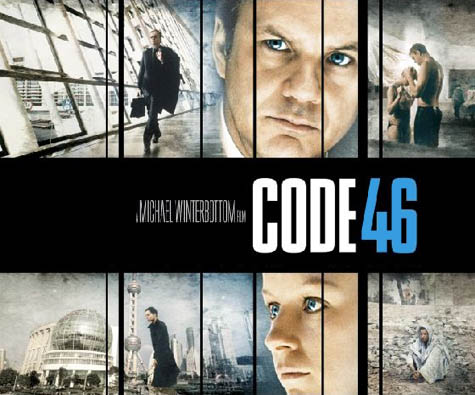 [Image: From Michael Winterbottom's Code 46, courtesy of United Artists].
[Image: From Michael Winterbottom's Code 46, courtesy of United Artists].
The purpose of the event is to talk about film and architecture – or, in this case, cities, urban design, memory, science fiction, landscape, globalization, and the built environment. As you can see from the list of locations used for the film's production, Code 46 is very well-traveled, stitching together urban – and exurban – environments from London, Shanghai, Dubai, Hong Kong, and even the deserts of Rajasthan.
That the film achieves the feel of science fiction simply through a well-edited depiction of existing landscapes says as much about the film as it does about the nature of city-building today; perhaps one might only half-jokingly suggest that people build cities today in order to live inside science fiction films.
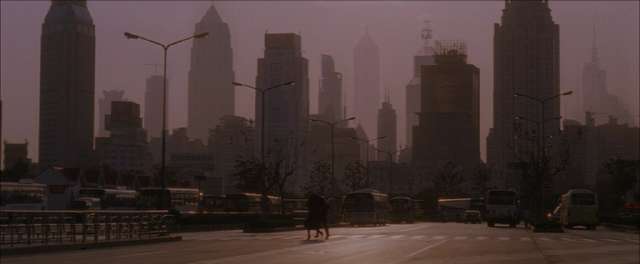 [Image: Shanghai, from Code 46, directed by Michael Winterbottom, courtesy of United Artists].
[Image: Shanghai, from Code 46, directed by Michael Winterbottom, courtesy of United Artists].
As BLDGBLOG explored the other week in a long post, "cities today are well known for popping up in the middle of nowhere, history-less and incomprehensible."
What does it mean, as well, that the depiction of the future in Code 46 – a depiction of the future through architecture – involves no U.S. cities at all and only very brief glimpses of urban infrastructure in Europe?
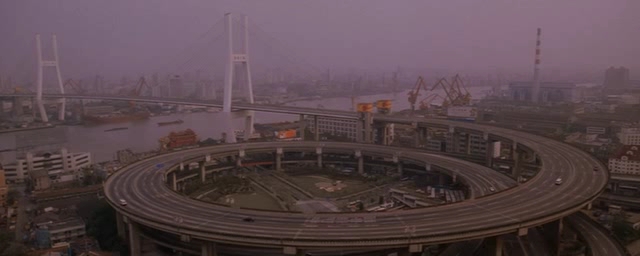 [Image: Shanghai, from Code 46, directed by Michael Winterbottom, courtesy of United Artists].
[Image: Shanghai, from Code 46, directed by Michael Winterbottom, courtesy of United Artists].
This brings up one of the more interesting aspects of the film – something not internal to it, but created by the current state of global urbanization. The film makes it deliberately unclear, in other words, that it was shot in multiple locations at all; the opening sequence blurs together landscapes, buildings, and infrastructures from very different cities – yet this unfamiliar new place to which we're being introduced might very well exist.
For all many viewers know, perhaps Shanghai really is in the middle of a desert; perhaps Dubai really does look exactly like Hong Kong.
This confusion only seems possible, however, within a very narrow window of historical time. As the skylines and iconic hotel interiors of Dubai, Shanghai, Hong Kong, and elsewhere become visually familiar to many more people, it will become much harder to do what Code 46 has done – which is to edit them all up into a convincing pastiche. They are a spatial collage, an urban cut-up – William S. Burroughs as architectural director.
In ten years, then, would this be akin to cutting from a shot of the Empire State Building to a shot of the Eiffel Tower and pretending that these landmarks are in the same city – only to find that almost no one has been genuinely tricked?
In a funny but negative Amazon review of the film, a disappointed viewer actually mocks this very aspect: "If I have to keep seeing these movies with the I haven't a clue which Metro I'm in look I'm going to scream."
But what does it mean that Asian cities – cinematically depicted as a kind of monolithic urban Other – are, for the time being, so visually unfamiliar to Western audiences that they can be edited into a seamless Global Metropolis, a vast agglomeration of spatial alterity that we can cut-and-paste together on film?
Where might Code 46 have been made if it had been produced fifteen years from now? What explosive urban outgrowths between now and then will be sufficiently unfamiliar to literally hundreds of thousands of filmgoers that they could be combined into one convincing location?
Will the sci-fi films of tomorrow be set in Lagos, Delhi, Rabat, or Shenzhen? All of the above?
It's the future science fiction of global third-tier urbanism.
For instance, one of the most striking aspects of the urban environment in The Matrix came simply from the fact that many – though not all – of the outdoor scenes were shot in Sydney, a city with which most American viewers are not visually familiar. The urban world of the Matrix thus took on an uncanny sense of near-resemblance, looking an awful lot like a city everyone has seen before – is that Houston? Tampa Bay? Fresno? – but not enough like any single one of them to be clear.
The film Primer, shot in Dallas, is an amazing example of this: the whole time you're watching it you have no idea where you are... though absolutely everything about it looks familiar.
The effect, particularly in Code 46, is almost literally uncanny.
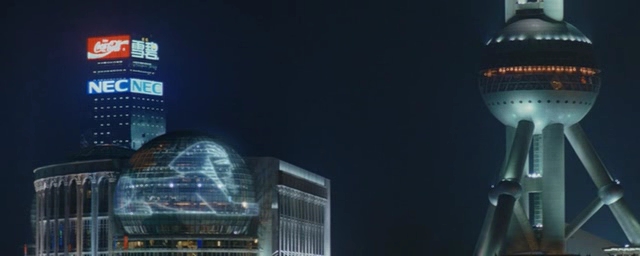 [Image: The Shanghai skyline, from Code 46, directed by Michael Winterbottom, courtesy of United Artists].
[Image: The Shanghai skyline, from Code 46, directed by Michael Winterbottom, courtesy of United Artists].
Briefly, I'm also reminded here of Tativille, the massive film-set city built by Jacques Tati to produce his own film Playtime. Constructed solely for the purpose of hosting camera crews – and later disassembled – Tativille was a city of the image, its design shaped only by how it would look on screen. With Tativille in mind, what might future audiences think if, say, Dubai really does run out of money in the global economic downturn, its towers abandoned and eroding back to sand? It will be visible in films like Code 46 – but nowhere else. It will have ceased to exist.
It will have been a kind of Tativille of the Emirates, built only to host film crews and car commercials.
In any case, the film's visions of desert poverty – scenes in Rajasthan – and desert opulence – scenes in Dubai – bring up the topic of uneven development. If, as William Gibson's oft-quoted line goes, the future is already here, it's just unevenly distributed, then this also appears to be true in the context of architectural form and urban landscapes.
But which one is the future: the nationless desert of rights-deprived exiles or the golf course-filled desert of the stateless business class?
Or are these perhaps one and the same, requiring each other as the flipsides of their own formation?
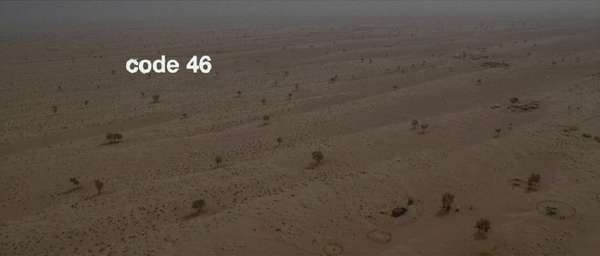 [Image: The opening titles of Michael Winterbottom's Code 46, courtesy of United Artists].
[Image: The opening titles of Michael Winterbottom's Code 46, courtesy of United Artists].
None of these questions are new, of course, going back in some form or another to Sergei Eisenstein, Fredric Jameson, and many, many others; but the opportunity to discuss all this with Michael Winterbottom himself in reference to a specific – and, as it happens, visually stunning – film, in a monumental and legendary architectural complex like the Barbican, is something of which I'm genuinely excited to be a part.
So if you're in London on Monday, November 24, consider stopping by. Tickets can be purchased directly through the Barbican's website, and you can learn a bit more about the film here.
This is part of an ongoing series called Architecture on Film, curated by the Architecture Foundation.
 [Image: From Michael Winterbottom's Code 46, courtesy of United Artists].
[Image: From Michael Winterbottom's Code 46, courtesy of United Artists].The purpose of the event is to talk about film and architecture – or, in this case, cities, urban design, memory, science fiction, landscape, globalization, and the built environment. As you can see from the list of locations used for the film's production, Code 46 is very well-traveled, stitching together urban – and exurban – environments from London, Shanghai, Dubai, Hong Kong, and even the deserts of Rajasthan.
That the film achieves the feel of science fiction simply through a well-edited depiction of existing landscapes says as much about the film as it does about the nature of city-building today; perhaps one might only half-jokingly suggest that people build cities today in order to live inside science fiction films.
 [Image: Shanghai, from Code 46, directed by Michael Winterbottom, courtesy of United Artists].
[Image: Shanghai, from Code 46, directed by Michael Winterbottom, courtesy of United Artists].As BLDGBLOG explored the other week in a long post, "cities today are well known for popping up in the middle of nowhere, history-less and incomprehensible."
- That’s what cities now do. If these cities are here today, they weren’t five years ago; if they’re not here now, they will be soon. Today’s cities are made up, viral, fungal, unexpected. Like well-lit film sets in the distance, staged amidst mudflats, reflecting themselves in the still waters of inland reservoirs, today’s cities simply arrive, without reservations; they are not so much invited as they are impossible to turn away. Cities now erupt and linger; they are both too early and far too late. Cities move in, take root and expand, whole neighborhoods throwing themselves together in convulsions of glass and steel.
What does it mean, as well, that the depiction of the future in Code 46 – a depiction of the future through architecture – involves no U.S. cities at all and only very brief glimpses of urban infrastructure in Europe?
 [Image: Shanghai, from Code 46, directed by Michael Winterbottom, courtesy of United Artists].
[Image: Shanghai, from Code 46, directed by Michael Winterbottom, courtesy of United Artists].This brings up one of the more interesting aspects of the film – something not internal to it, but created by the current state of global urbanization. The film makes it deliberately unclear, in other words, that it was shot in multiple locations at all; the opening sequence blurs together landscapes, buildings, and infrastructures from very different cities – yet this unfamiliar new place to which we're being introduced might very well exist.
For all many viewers know, perhaps Shanghai really is in the middle of a desert; perhaps Dubai really does look exactly like Hong Kong.
This confusion only seems possible, however, within a very narrow window of historical time. As the skylines and iconic hotel interiors of Dubai, Shanghai, Hong Kong, and elsewhere become visually familiar to many more people, it will become much harder to do what Code 46 has done – which is to edit them all up into a convincing pastiche. They are a spatial collage, an urban cut-up – William S. Burroughs as architectural director.
In ten years, then, would this be akin to cutting from a shot of the Empire State Building to a shot of the Eiffel Tower and pretending that these landmarks are in the same city – only to find that almost no one has been genuinely tricked?
In a funny but negative Amazon review of the film, a disappointed viewer actually mocks this very aspect: "If I have to keep seeing these movies with the I haven't a clue which Metro I'm in look I'm going to scream."
But what does it mean that Asian cities – cinematically depicted as a kind of monolithic urban Other – are, for the time being, so visually unfamiliar to Western audiences that they can be edited into a seamless Global Metropolis, a vast agglomeration of spatial alterity that we can cut-and-paste together on film?
Where might Code 46 have been made if it had been produced fifteen years from now? What explosive urban outgrowths between now and then will be sufficiently unfamiliar to literally hundreds of thousands of filmgoers that they could be combined into one convincing location?
Will the sci-fi films of tomorrow be set in Lagos, Delhi, Rabat, or Shenzhen? All of the above?
It's the future science fiction of global third-tier urbanism.
For instance, one of the most striking aspects of the urban environment in The Matrix came simply from the fact that many – though not all – of the outdoor scenes were shot in Sydney, a city with which most American viewers are not visually familiar. The urban world of the Matrix thus took on an uncanny sense of near-resemblance, looking an awful lot like a city everyone has seen before – is that Houston? Tampa Bay? Fresno? – but not enough like any single one of them to be clear.
The film Primer, shot in Dallas, is an amazing example of this: the whole time you're watching it you have no idea where you are... though absolutely everything about it looks familiar.
The effect, particularly in Code 46, is almost literally uncanny.
 [Image: The Shanghai skyline, from Code 46, directed by Michael Winterbottom, courtesy of United Artists].
[Image: The Shanghai skyline, from Code 46, directed by Michael Winterbottom, courtesy of United Artists].Briefly, I'm also reminded here of Tativille, the massive film-set city built by Jacques Tati to produce his own film Playtime. Constructed solely for the purpose of hosting camera crews – and later disassembled – Tativille was a city of the image, its design shaped only by how it would look on screen. With Tativille in mind, what might future audiences think if, say, Dubai really does run out of money in the global economic downturn, its towers abandoned and eroding back to sand? It will be visible in films like Code 46 – but nowhere else. It will have ceased to exist.
It will have been a kind of Tativille of the Emirates, built only to host film crews and car commercials.
In any case, the film's visions of desert poverty – scenes in Rajasthan – and desert opulence – scenes in Dubai – bring up the topic of uneven development. If, as William Gibson's oft-quoted line goes, the future is already here, it's just unevenly distributed, then this also appears to be true in the context of architectural form and urban landscapes.
But which one is the future: the nationless desert of rights-deprived exiles or the golf course-filled desert of the stateless business class?
Or are these perhaps one and the same, requiring each other as the flipsides of their own formation?
 [Image: The opening titles of Michael Winterbottom's Code 46, courtesy of United Artists].
[Image: The opening titles of Michael Winterbottom's Code 46, courtesy of United Artists].None of these questions are new, of course, going back in some form or another to Sergei Eisenstein, Fredric Jameson, and many, many others; but the opportunity to discuss all this with Michael Winterbottom himself in reference to a specific – and, as it happens, visually stunning – film, in a monumental and legendary architectural complex like the Barbican, is something of which I'm genuinely excited to be a part.
So if you're in London on Monday, November 24, consider stopping by. Tickets can be purchased directly through the Barbican's website, and you can learn a bit more about the film here.





Comments are moderated.
If it's not spam, it will appear here shortly!
I still haven't made it through all of the Winterbottom film, although that's due more to the plot than the architecture.
I can't help but think of Tarkovsky's Solaris and its use of Japan's roadways as a stand-in for a the future world as seen from the early 1970s.
"This confusion only seems possible, however, within a very narrow window of historical time. As the skylines and iconic hotel interiors of Dubai, Shanghai, Hong Kong, and elsewhere become visually familiar to many more people, it will become much harder to do what Code 46 has done – which is to edit them all up into a convincing pastiche."
not sure i agree with this. it's done all the time with los angeles. true, it often isn't convincing to any of us that know the town (point break anyone?), but i've been watching 'dexter', which takes place in florida but shoots in los angeles, and it wasn't until the 3rd episode of the 3rd season that i saw a location i positively recognized (it was the campus of loyola marymount).
i agree with the previous poster, how much you're willing to go with the illusion probably has a lot to do with how engaging the plot is. even architecture can be helped by a good story!
Looking forward to it. Do you have other engagements in London while you are here?
This is on the Tuesday:
ART AND ARCHITECTURE AUTUMN LECTURES 2008: THE PSYCHOLOGY OF SPACE
Psychology of Space: Bizarre or Surreal, at The Gallery, Cowcross Street, London.
25 November 2008
Michael.
This is a great movie to reference in a future urban context. The use of post-globalization language is fantastic. The film does have some big flaws, but remains interesting for bringing up valid points about the future of urbanism.
I wrote an article about Code 46 back in 2005 on the Dutch architecture portal ARCHINED.
Nice to see it pop up on BLDGBLOG. it's a great movie which communicates a lot of (distopian) scenario's for urban evolution.
for article called 'Capsular Love'(in dutch) see:
http://www.archined.nl/archined/4734.0.html
This is a great movie, and i shall be there on 24th. When I did my Urban Design Masters at Westminster Uni we did a module called 'City on Film' and doing the research on that was fascinating. Some great books around on the topic from memory ...
I really enjoyed Code 46, and remember how the architecture in it stood out to me.
I almost enjoyed the film more for the atmosphere and 'sets' than for the story itself, though I do remember recommending it to people.
Hope you enjoy your talk. Unfortunately, Austin is a long way from London, especially on my income.
Ah, to be a world traveling denizen of the future!;)
(Which reminds me, 'Until the end of the World' was another film that had moments of that current architecture giving you the feel of an sf future -- especially the scenes in Tokyo with the tiny hotel 'rooms'.)
I'll be at this! Looking forward to it.
i would dearly love to go- but its sold out-if anyone has a spare ticket please let me know! I was so inspired by this film, but I never saw it in the cinema before... I think it captures an incredible experience of the future and the city, and i disagree its a pastiche...
if anyone does have a spare ticket, please email me-
airmail@atelierdetroit.com thanks- and enjoy
Deepstructure, sorry it's taken so long to reply to your comment! But I'd say a few things here. With your specific example I would agree - but only if the following two things aren't true:
1) I think the reason LA can stand-in for so many other places is precisely because of its famously featureless and landmark-free landscape. It doesn't have, say, an Eiffel Tower or a 5th Avenue or a Piccadilly Circus to give itself away. Shots of the Hollywood sign, or the pier, sure; but I think that random streets and high schools and parking lots and so on throughout the city could really be anywhere - Bakersfield, San Jose, Miami, Mexico City. So it's a particularly North American anywhere, perhaps. In other words, I think what you're saying is true - but only because LA is precisely unrecognizable (unless you live near that specific parking lot that was used to represent Atlanta in that recent TV show...).
2) It will always be possible to film a movie somewhere that will make the setting pass for somewhere else - but I think as cities like Dubai and Shanghai, etc., become more instantly recognizable, a scene that shows people leaving Shanghai by car only to end up in the middle of a desert will be progressively more jarring to watch. Of course, I'm instantly reminded here of Seven, where the - if I remember correctly - unnamed Manhattan-like city fades off on its edges into deep California desert. This is done very convincingly. But my ultimate point here is that I think the instant cities of Dubai, Shanghai, Abu Dubai, etc., haven't yet been visually metabolized enough to resist these sorts of editorial tricks.
Anyway, I think there are dozens of for and against examples here; but I would say that I agree with your point only to the extent that this is almost exactly what LA is famous for: being a kind of featureless nowhere and a stand-in for everywhere. You could be everywhere, anywhere, and nowhere in LA - which is actually one of the reasons I liked living there so much. It's like some strange microcosm for the sum total of all North American geography.
Also, let me add one other quick point of reference here: Alphaville, which was filmed entirely within existing office buildings.
One more thing - though I have an actual post planned to announce this: Mark Tildesley, production designer for Code 46, Sunshine, 28 Days Later, Millions, and many, many, many others will also be part of the post-screening conversation. So I'll be interviewing Michael Winterbottom and Mark Tildesley both. Very exciting!
I particularly enjoy the third image, which recreates Peter Bialobrzeski’s photograph of Nanpu bridge in Shanghai, that was at the center of a plagiarism accusation a few years ago (covered
here).
Tucked casually into a film about individual action in the context of totalizing regulation and biological reproduction-and in light of your discussion of the deliberate conflation of many cities into one-I thought it was a very clever reference to the way even the banal landscapes of otherwise unfamiliar, interchangeable cities can become highly particular, even individual.
Would have been nice to get some warning on the [SPOLIER ALERT] quasi-incestuous quasi-rape scene. Eww.
I was thinking of Eisenstein and Vertov while reading your article and well before the end. Which is weird. Perhaps the article called them to mind because their genius was in exploring the narrative edges of their world within the technical limits of that world. They expanded cinematic vision to encompass a City as a character. I haven't seen Code 46. Have no idea if it will hold my interest. But perhaps it will be remembered for expanding cinematic vision to encompass a planet of Cities as a character.
Post a Comment